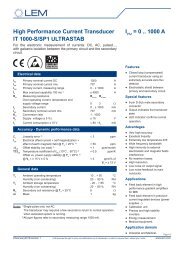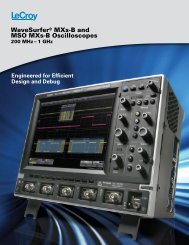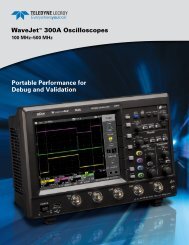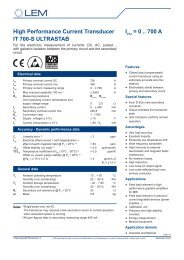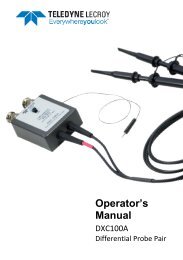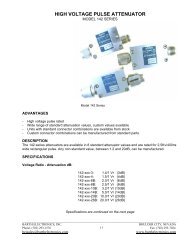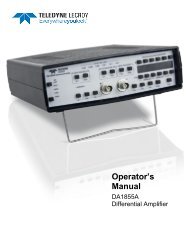IZT S2000 - Innovationszentrum für Telekommunikationstechnik ...
IZT S2000 - Innovationszentrum für Telekommunikationstechnik ...
IZT S2000 - Innovationszentrum für Telekommunikationstechnik ...
You also want an ePaper? Increase the reach of your titles
YUMPU automatically turns print PDFs into web optimized ePapers that Google loves.
Profiles<br />
Carrier power, relative delay between the three<br />
signals, center frequency and carrier-to-noise can<br />
be varied through user-defined profiles to simulate<br />
the moving satellites and large-scale fading.<br />
The profiles have a timing resolution of two<br />
milliseconds and can be synchronized to the<br />
wave form content for repeatable test scenarios.<br />
figure 3: Power level profiles generating<br />
short burst sequences<br />
figure 4: Power level profiles to simulate<br />
large scale fading<br />
figure 5: Sirius terrestrial signal<br />
undistorted (blue), simulated nonlinearity<br />
unfiltered (black) and filtered (green)<br />
Nonlinearity and output filter simulation<br />
For real-world simulation of the signals, the nonlinear<br />
behaviour of the power amplifier in the<br />
sa tellites and terrestrial repeaters have to be modelled.<br />
The <strong>IZT</strong> <strong>S2000</strong> allows accurate nonlinearity<br />
simulation which is independently settable for<br />
each carrier and monitoring of the signal parameters.<br />
The nonlinearity simulation is combined<br />
with a digital representation of the transmitter<br />
output filter.<br />
figure 6: Sirius terrestrial signal with<br />
two-path fading model<br />
figure 7: Sirius terrestrial signal with<br />
raleigh fading<br />
Channel Simulator<br />
The <strong>IZT</strong> <strong>S2000</strong> contains independent channel simulators<br />
for all three signals. Two-path models are<br />
used for the satellites QPSK signals and an eight<br />
path model for the terrestrial COFDM signal.<br />
figure 8: Sirius terrestrial signal with<br />
out-of-band interferer<br />
Interference Signals<br />
For testing Sirius receivers, the <strong>IZT</strong> <strong>S2000</strong> can<br />
generate various out-of-band interferers with an<br />
exceptional dynamic range and signal quality. For<br />
XM interference simulation, an accurate spectral<br />
representation of the XM terrestrial signals can<br />
be generated. Other interference sources, like<br />
WCS or cellular phone signals can be stored in<br />
the <strong>IZT</strong> <strong>S2000</strong>’s built-in Arbitrary Waveform Generator<br />
with adjustable output power and center<br />
frequency.



